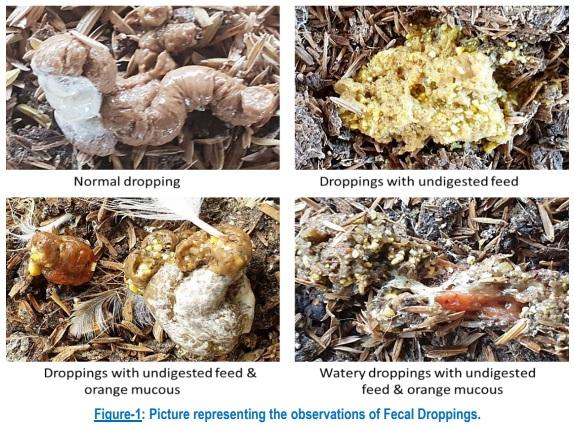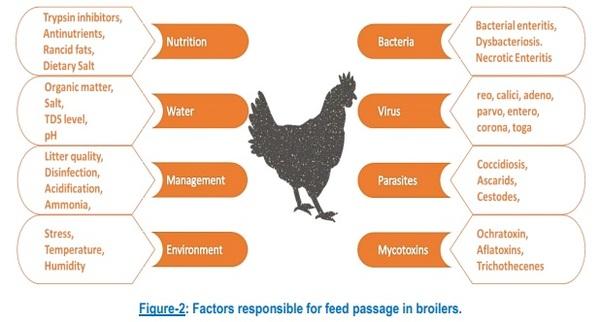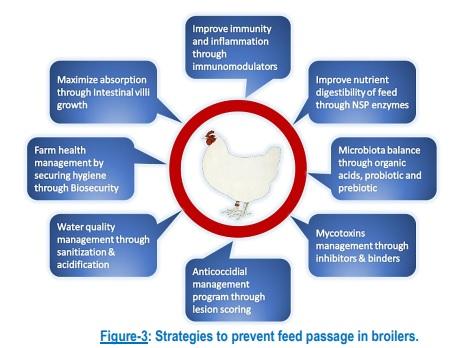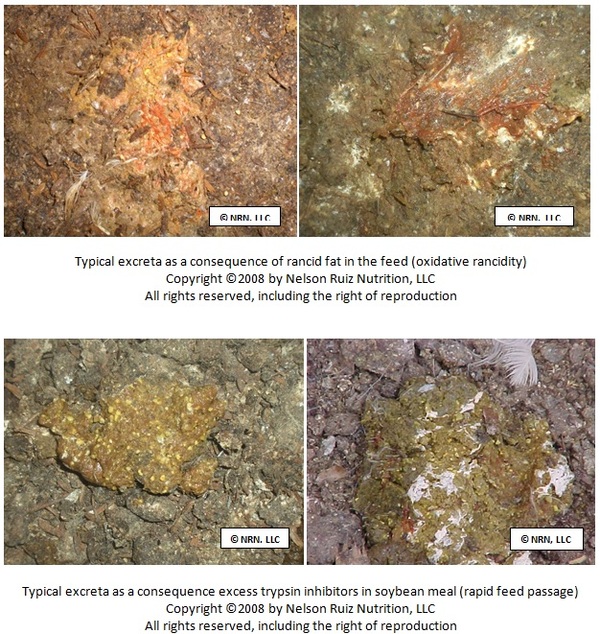Feed Passage Syndrome: An Integrated Approach to Improve Birds Health


 Quality of feed ingredients should be improved by focusing on the consistency of grains, soya and fat quality; addition of enzyme preparations to avoid undigested feed to be the substrate for pathogenic microorganisms. Modification of the diet and addition of exogenous enzymes to wheat, barley, oat or rye-based diets can considerably decrease NSP level and reduce the risk of necrotic enteritis in flocks fed with these cereals. Minimizing the level of fishmeal, wheat, barley or rye in the diet can help prevent this condition. Apart from this, such type of issues can be avoided by desirable feed quality along with everyday cleaning and disinfection of feeding equipments; removal of any caked and moldy residues lodged within the system.
Quality of feed ingredients should be improved by focusing on the consistency of grains, soya and fat quality; addition of enzyme preparations to avoid undigested feed to be the substrate for pathogenic microorganisms. Modification of the diet and addition of exogenous enzymes to wheat, barley, oat or rye-based diets can considerably decrease NSP level and reduce the risk of necrotic enteritis in flocks fed with these cereals. Minimizing the level of fishmeal, wheat, barley or rye in the diet can help prevent this condition. Apart from this, such type of issues can be avoided by desirable feed quality along with everyday cleaning and disinfection of feeding equipments; removal of any caked and moldy residues lodged within the system.During fermentation, the material gets wet and will require a process to get it dried. This may involve additional costs and concomitant problems of improper drying like fungus contamination will open new areas. Reduction in antinutrients and increasing the nutrient availability is a welcome finding in the study.
Two quick responses:
1- Although we have not analyzed residual hexane in lots of commercial soybean meals involved in rapid feed passage in the field, there is not much justification to do that. First, hexane has been the main solvent used in the solvent-extraction process well before the 1990's when rapid feed passage started to be observed worldwide. Second, oilseed processing plants are quite efficient in removing hexane from soybean meal, canola meal, sunflower meal not only for economic reasons but also for safety reasons. To the best of my knowledge, the maximum allowable level of hexane in soybean meal is 500 PPM. Therefore, if this is the maximum, very likely much lower levels would be expected to be found in commercial lots of soybean meal.
2- The wet chemistry for trypsin inhibitors determination is very well defined in the AOCS Methods, AACC Methods as well as in the European ISO Methods. To the best of my knowledge, there are no kits to measure accurately trypsin inhibitors. Several commercial laboratories in and out of the United States offer trypsin inhibitor analysis.
Dear Mr. Ruiz,
Makes a lot of sense. And I think it looks different with us, as we don't use that high level of Soja anymore. But still we found the last years a lot of trypsin-inhibitors when searching for it in Soyabean. More in local production from small companies but still too from big once. This is why we are working on ways to ferment the raw soyabean with new technologies.
For us, the shape looks different but I think due to the different processing and systems it is very close.
I have no idea how I can upload some pics here otherwise I would have sown you.
We have great success in stopping it if we start around 5 days before in using new kind of acid mixes in the drinking water. As this mix contains new kinds of midd chain fatty acid. They control the formation of negative bacteria and strengthen the walls of the digestion tract. As well as a high load of specific and new developed emulsifiers and as we put AOX inside as well I think it fits 1:1 to your explanation.
Now the last miracrles are clearing off.
Thanks for that.
Interesting. Can you tell at which age this shows up at most?
As we have such things seen again in the last year. But more brown and bubbling. And it is called till now 21 days illness but what we can say till now we find undigested feed and a cocktail of different bacteria out of range.
But we see that it often starts to show up at day 21 +- 3 days and not much stopped it till we found a combination of things who stops it and the farmers affected have it now under control. We have seen it even with high digestible feed. So would be interesting if yours and what we have seen in Germany and now in Netherland and Spain are the same. As some of the pics look very close.
The following are comments on your interesting paper on rapid feed passage. Just for practical purposes and to make the discussion easier we always define what is rapid feed passage before we talk about it to be sure we are talking about the same issue: "Rapid feed passage is defined here as the condition in which broiler droppings lose their normal shape and consistency, do not display the characteristic white uric acid cover, contain undigested feed that is visible to the naked eye, usually have a yellowish-orange color, are frequently watery and contain sloughed intestinal tissue. Broilers in a flock experiencing a rapid feed passage outbreak have extremely dirty feathers, lack body weight uniformity and display poor pigmentation. As a consequence, the litter becomes wet and slippery, feed conversion is negatively affected, body weights are lower than the desired standard and considerable economic losses may be realized." So, our comments are:
1- It looks like we are talking about the same syndrome you describe in your paper and interestingly, you go back to outbreaks as early as 1996, which I am assuming were in Southeast Asia. Actually, we started to face outbreaks of rapid feed passage in 1998 in the north of South America.
2- Although you refer to rapid feed passage as something sporadic now and then, our experience is that evidently the severity of the outbreaks are less now than at the end of the 1990's and beginning of the 2000's, but the occurrence is not sporadic. It is still occurring in several geographies not only in South America but worldwide. In fact, at a USSEC Seminar in Medellin, Colombia in 2018 which was attended by several of their customers from Mexico to Bolivia over 50% of the audience raised their hand when asked if rapid feed passage was observed in their poultry farms. The fact that the syndrome is better understood today (as I will discuss further down in these comments) makes it less severe because farm managers switch to a different lot of feed immediately.
3- The photos in your paper are very much similar to what we have observed in the field and we have published [Ruiz, N. 2012. Transito rapido tied to soybeans. Feedstuffs, January 30]. Therefore, this is a confirmation that we are talking about the same syndrome. The term "transito rapido" in the title of the Feedstuffs article means "rapid feed passage" in Spanish (and also in Portuguese). For some reason, the Editor of Feedstuffs found it interesting and decided to publish the article using this Spanish term instead of "rapid feed passage" for the audience of Feedstuffs, which presumably is English speaking. Therefore, the impact of the message was quite limited and very few people paid attention to that paper.
4- The title of your paper, however, as well as the contents of Figure 2 ("Factors responsible for feed passage") imply that the rapid feed passage syndrome is multi-factorial. Well, we don't find that exactly to be the case, and here is my explanation which I offer with no other intention than opening the debate because this is one of the purposes of Engormix fora:
A- When we faced very intensive rapid feed passage outbreaks back in 1998, we, of course, have no clue what was the etiology. However, we started to investigate immediately. Between 1998 and 2004 we faced six major outbreaks of the syndrome in broiler integrated farms in Venezuela, Ecuador, Peru, and Colombia. However, by mid-2004 and after a considerable investment in tests and analyses for innumerable possible hypotheses and "theories" ranging from 21 different mycotoxins, to 10 biogenic amines, pesticide contamination and other hypotheses, we reached two main conclusions: first, that peculiar lots of soybean meal processed at different origins were involved in the causation of the syndrome, and second, that the content of trypsin inhibitors in those peculiar lots were correlated to rapid feed passage outbreaks in the field. When you say in your paper that "some authors claimed that trypsin inhibitors present in soybean meal were directly linked to feed passage outbreaks" certainly, those authors are us.
B- Because we believed our data were solid enough we presented them at the Annual Meeting of the Poultry Science Association in 2005 [Ruiz and Belalcazar. Field observation: Trypsin inhibitors in soybean meal are correlated with outbreaks of feed passage in broilers. Poultry Science 84(Suppl. 1): 70.] and also at the Annual Convention of the American Veterinary Medicine Association in 2006. The above citation corresponds to the Abstract of the presentation at the Poultry Science Association meeting, but a detailed description and interpretation of the field observations were published in 2012 [Ruiz, N. New insights on the urease activity range for soybean meal: a worldwide opportunity for the poultry industry. 2012 Arkansas Nutrition Conference Proceedings. And also the above referenced paper in Feedstuffs]
C- Your paper makes a good discussion on necrotic enteritis and coccidiosis as connected somehow to rapid feed passage. However, in the outbreaks that we investigated between 1998 and 2004 neither of these two diseases were involved. Rapid feed passage is an independent problem that, however, may co-occur with necrotic enteritis and/or coccidiosis. When the definition described in the first paragraph of these comments is considered, that is, UNDIGESTED FEED WITH OR WITHOUT THE PRESENCE OF INTESTINAL SLOUGHING TISSUE this is absolutely independent of cocci lesions and/or necrotic enteritis.
D- Very frequently (not always) rapid feed passage is accompanied with increased wetness of the droppings, but this is not to say that rapid feed passage is a diarrhea. Actually, as we all know there are many etiologies for situations such as wet droppings, wet litter, diarrhea. However, electrolyte imbalance as when there is excess formulated chloride in the feed has nothing to do with rapid feed passage and it doesn't generate the picture described in the definition. Neither excess sodium nor excess potassium in the feed (or in the drinking water) has anything to do with rapid feed passage.
E- During the over 20 years that we have investigated and observed rapid feed passage in the field, we have not encountered the first event correlated to analyzed mycotoxins. Some mycotoxins such as deoxynivalenol, and fumonisins which are almost normal components of cereal grains at levels well below the toxic levels suggested as maximum allowable per the FDA and EFSA recommendations may, of course, be detected and measured. But outbreaks of rapid feed passage in broiler flocks documented with a specific mycotoxin as the cause, in our experience, remains to be found. Now, avian histopathologists are well trained to correlate tissue damage and toxicants. Mycotoxins are fundamentally toxicants but they are not pathognomonic for chickens, therefore a lesion that under the microscope may appear as related to a specific mycotoxin is then listed in the correspondent report. Avian histopathologists in general are not familiar with trypsin inhibitor lesions, so they don't identify them, and consequently, trypsin inhibitors are not listed in histopathologic reports. We learned this because in our only experience with rapid feed passage in broiler breeders we submitted tens of samples of intestinal tissues to a qualified histopathology lab and the reports where invariant: "a toxicant is present - lesions consistent with mycotoxins". And when I say "tens of samples" is literal because this was an interesting case in the field in which the general manager of the integrated poultry business did not believe and did not accept our diagnosis that broiler breeders were experiencing a severe case of non-specific enteritis (also in the histopathological reports) caused by excess of trypsin inhibitors in the soybean meal formulated in the feed. The company was importing soybean meal per a long-term contract from one single specific oilseed processing plant. Since this situation lasted for over a year, we had a magnificent opportunity to study the effect on broiler breeders of the prolonged exposure to high levels of trypsin inhibitors which we presented at the Annual Meeting of the Poultry Science Association in 2008 [Ruiz, N., E.A. Vargas, and F. de Belalcázar. 2008. Field observation: Effects of long term feeding of soybean meal high in trypsin inhibitors to broiler breeders. Poultry Science 87(Suppl. 1): 30.].
F- The "viral theory" that rapid feed passage is caused by a virus which appears and disappears in the field has been suggested by some colleagues without any further development of the concept. Actually, for some time there has been a confusion thinking that the rapid feed passage syndrome is the same as the runting/stunting and malabsorption syndrome which was first reported in 1977 [Olsen, D.E. 1977. Isolation of a reovirus-like agent from broiler chicks with diarrhea and stunting. Proc. 26th Western Poultry Disease Conference, Davis, California]. No isolation of a virus has been reported in the scientific literature, to the best of my knowledge in relation to rapid feed passage.
G- No academic research has been reported on rapid feed passage and trypsin inhibitors in poultry. However, Schulze in the Netherlands studied the effects of trypsin inhibitors on the digestion of growing swine and demonstrated the endogenous and exogenous nitrogen losses realized by crystalline trypsin inhibitors in a semi-purified diet. The levels of trypsin inhibitors tested in his experiments would be consistent with excess trypsin inhibitors in a commercial soybean meal lot [Schulze, H. 1994. Soybean trypsin inhibitors affect ileal endogenous and exogenous nitrogen flow in pigs. PhD Thesis. Chapter 5. Agricultural University of Wageningen, The Netherlands http://library.wur.nl/WebQuery/wurpubs/25447]. Therefore, in the absence of a similar research with broilers, but in the presence of abundant field and analytical data it is not inappropriate to speculate that the undigested feed feature observed in rapid feed passage is part of the exogenous nitrogen losses, and that the sloughing intestinal tissue is part of the endogenous nitrogen losses. Of course, it is a speculation, remains to be demonstrated. To the best of my knowledge, only the research group led by Dr. Ducatelle at Ghent University has come close to investigate rapid feed passage since they have worked on dysbacteriosis in broilers. It is my opinion that rapid feed passage can be considered also as a form of dysbacteriosis. However, the group at Ghent University have not contemplated soy trypsin inhibitors as part of their research, they have used instead rye as part of their model, an irrelevant ingredient worldwide.
H- Finally, in your long list of factors that may be responsible for rapid feed passage you mention fat rancidity. Yes, I agree with you. Although it is a different toxicant, oxidative rancidity in broilers as a consequence of feeding rancid fat in the feed generates excreta that resemble rapid feed passage. It is not exactly the same, but for practical purposes, we call it rapid feed passage, and consequently, when we are investigating a new case in the field it is necessary to define if the cause is trypsin inhibitors or rancid fat. Those are the only two possible etiologies, so far, that we consider. Below I am sharing photos that illustrate both situations. Rancid fats tend to generate more sloughing intestinal tissue and less undigested feed in the excreta. The opposite seems to occur when trypsin inhibitors are the cause. Nelson Ruiz Nutrition, LLC, Suwanee GA, USA.

Dear All,
This is Dr Channegowda from Zeus Biotech India.
As Dr Kotaiah said: we have already tried fermenting soybean meal and results of initial trials are attractive but it is a lengthy process. It takes nearly 24 hours. But totally natural and very safe with no carrier material or filler material.
Very interesting topic and very useful as I have been seeing a very similar pattern at 21 days, one thing that does buck the trend is growth and FCR are not affected. Litter goes from dry and friable to greasy and capped in 24hrs! Once the litter is capped it is unretrievable.









.jpg&w=3840&q=75)







.jpg&w=3840&q=75)